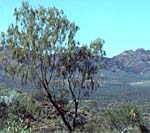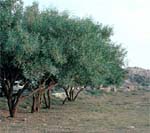|
|
|
In Australia, a significant economic use of the foliage and green pods of acacias has been as stock fodder, especially during times of drought. Species used for this purpose include: A. aneura (Mulga), A. argyrodendron (Black Gidyea), A. blakei (Blake's Wattle), A. cuspidifolia (Wait-a-while), A. deanei (Green Wattle), A. estrophiolata (Ironwood), A. harpophylla (Brigalow) , A. kempeana (Witchetty Bush), A. omalophylla (Yarran), A. pendula (Weeping Myall), A. pruinocarpa (Black Gidgee), A. saligna (Coojong), A. sparsiflora (Currawong), A. stenophylla (Eumong), A. tenuinervis (Scrub Wattle) and A. victoriae (Gundabluey) (see Everist, 1969; Hall et al., 1972; Weller, 1974; Askew & Mitchell, 1978; Cunningham et al., 1981; Mitchell & Wilcox, 1994; Thomson et al., 1994; Lithgow, 1997). The Acacia aneura group in particular provide important fodder for sheep in the arid-zone rangelands of Australia; the latest revision of this group presented in the current Flora of Australia volumes 11A and 11B, should lead to a better understanding of the biological attributes of this species complex. Overseas, species such as A. saligna have been used extensively in regions such as North Africa and South America as a fodder plant for sheep and goats (El-Lakany, 1987; Houerou, 2000); its potential for use in south-western Australia is currently being re-assessed. As noted by Thomson et al. (1994) however, the value of Australian acacias as fodder plants should not be overstated; in general these species appear to have relatively low nutritive value and/or digestibility, and their prime role is as a drought fodder reserve. The foliage of some species, notably A. georginae (Georgina Gidgee), may be extremely poisonous to stock (Everist, 1981). Poisoning seriously affects sheep and cattle production in areas where natural stands of this species occurs (Barnes, 1958). Digestibility and nutrient analyses of 29 acacias are given in Vercoe (1989).
References
Askew, K. & Mitchell, A.S. (1978), The Fodder Trees and Shrubs of the Northern Territory. Division of Primary Industry Extension Bull. No.16.
Barnes, J.E. (1958), Georgina poisoning of cattle in the Northern Territory, Austral. Veterin. J. 34: 281-290.
Cunningham, G.M., Mulham, W.E., Milthorpe, P.L.& Leigh, J.H. (1981), Plants of Western New South Wales. Soil Conservation Service of New South Wales, Sydney.
Dynes, R.A. and Schlink, A.C. (2002). Livestock potential of Australian wattle species. Conservation Science Western Australia 4(3): 117-124. Download this paper (PDF).
El-Lakany, M.H. (1987), Use of Australian acacias in North Africa, in J.W.Turnbull (ed.), Australian Acacias in Developing Countries. ACIAR Proceedings No.16, pp. 118-125. Australian Centre for International Agricultural Research, Canberra.
Everist, S.L. (1969), The Use of Fodder Trees and Shrubs. Advisory Leaflet 1024, Division of Plant Industry, Department of Primary Industries, Queensland.
Everist, S.L. (1981), Poisonous Plants of Australia. 2nd edn. Angus and Robertson, Sydney.
Hall, N.H., Boden, R.W., Christian, C.S., Condon, R.W., Dale, F.A., Hart, A.J., Leigh, J.H., Marshall, J.K., McArthur, A.G., Russell, V. & Turnbull, J.W. (1972), The Use of Trees and Shrubs in the Dry Country of Australia. Australian Government Publishing Service, Canberra.
Houerou, le H.N. (2000), Utilization of fodder trees and shrubs in arid and semiarid zones of West Asia and North Africa, Arid Soil Res. Rehab. 14: 101-135.
Howard, D., Krebs, G.L. and van Houtert, M. (2002). The value of Acacia saligna as a source of feed for sheep. Conservation Science Western Australia 4(3): 135-138. Download this paper (PDF).
Krebs, G.L., Howard, D., May, D. and van Houtert, M. The value of Acacia saligna as a source of fodder for ruminant. Download this paper from the RIRDC site.
Lithgow, M.G. (1997), 60 wattles of the Chinchilla and Murilla Shires. Private publication. Chinchilla, Queensland.
Mitchell, A.A. & Wilcox, D.G. (1994), Arid Shrubland Plants of Western Australia. University of Western Australia Press and Department of Agriculture, Western Australia.
Thomson, L.A.J., Turnbull, J.W. & Maslin, B.R. (1994), The utilization of Australian species of Acacia, with particular reference to those of the subtropical dry zone, J. Arid Environm. 27: 279-295.
Vercoe, T.K. (1989), Fodder value of selected Australian tree and shrub species, in D.J.Boland (ed.). Trees for the Tropics, ACIAR Monograph No. 10, pp.177-186. Australian Centre for International Agricultural Research, Canberra.
Weller, M.G. (1974), Mulga as drought feed for cattle, Queensland Agric. J. 100: 530-538.

